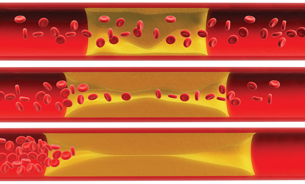Module 8 Intro
1. Module 8 Intro
1.14. Page 5
Module 8—Circulation, Immunity, and Excretion
 Read
Read
Cardiovascular Disorders and Treatments

© Sebastian Kaulitzki/shutterstock
A common disorder of the circulatory system is a buildup of plaque (fat deposits) on the walls of the arteries. This disease, arteriolsclerosis, has many symptoms. The patient may feel chest pain, experience shortness of breath, and have high blood pressure. If the arteries continue to reduce in size, a blockage of an artery can lead to a stroke or a heart attack. Lifestyle choices such as smoking, a lack of exercise, and high-fat diets greatly increase the risk of developing this disease.
Look at the photo showing arteriolsclerosis. Imagine a garden hose. What happens to the flow of water when you put your thumb over the end of the hose to make the opening smaller? Water moves with greater force. By reducing the area that a fluid moves through, you will increase pressure. This is the same principle behind increased blood pressure due to arteriolsclerosis.
congenital: appearing at birth due to a heredity/genetic abnormality or from complications during a pregnancy
mitral stenosis: a heart valve disorder that narrows or obstructs the mitral valve opening
Some circulatory system problems are not a result of lifestyle choices. Many heart problems exist from birth and are congenital. Congenital heart defects include problems in the walls dividing the chambers of the heart and in the valves or in the structure of blood vessels around the heart. Many of these defects are detected at birth through a heart murmur, through blueness of the skin, or through technologies such as cardiac echocardiograms and cardiac catherizations. With the advancement of technology, many of these defects are being corrected with increasing success.
An example of a congenital heart disease is mitral stenosis. The mitral valve (which you know as the left bicuspid atrioventricular valve) is narrowed. It takes more effort for the left atrium to pump the blood through the narrowed valve to the left ventricle. This causes a rise in pressure in the left atrium. The walls of the left atrium then become thickened and the atrium enlarges.
Remember that flow moves from high pressure to low pressure. A back pressure of blood may then cause blood to move backwards in the blood vessels which bring blood to the left atrium (the pulmonary veins which bring blood from the lungs). This can be identified as an extra heart sound, or murmur, when a doctor uses a stethoscope. Also, the amount of blood leaving the ventricle is reduced. The heart does not pump efficiently and less blood reaches the body with each contraction, compared to a healthy heart. Some symptoms include fatigue, dizziness, or fainting.
Both arteriolsclerosis and mitral stenosis can be treated by surgery. Symptoms of the diseases can be controlled by medicine. Technological advances in medicine have been refined to help people regain homeostasis in their bodies.
Narrowing the mitral valve prevents the valve from opening properly and obstructs blood flow from the left atrium to the left ventricle. This can reduce the amount of blood that flows forward to the body.
Read “Cardiovascular Disorders and Treatments,” starting on page 277 of your textbook. You may want to make a chart of technologies that are used to diagnose and treat these disorders. This may help you when you come to your Unit D Assessment, where you will be conducting research. Save your chart in your course folder.
 Going Beyond
Going Beyond
Imagine that you are a surgeon who is performing a virtual heart transplant. Use the keywords “nova, virtual, and heart transplant” in a web search to locate the virtual activity.
Through this virtual operation you can see the steps involved in performing a transplant. It is amazing how far medical technology has progressed to benefit people.
 Module 8: Lesson 2 Assignment
Module 8: Lesson 2 Assignment
Remember to submit the Assignment answers to your teacher as part of your Module 8: Lesson 2 Assignment.